There are places in the world where Christmas feels different—where time seems to pause and the festive spirit blends with centuries of history. That’s exactly how Christmas in Cusco is experienced, a magical setting that brings together faith and Andean tradition.
In Cusco, Christmas is a living experience that transports you through colorful streets, balconies filled with the scent of hot chocolate, and the pleasant sound of Quechua carols echoing between church bells. It’s a celebration that reaches the soul.
Are you ready to discover why Christmas in Cusco is not only celebrated but truly felt like nowhere else in the world?
Table of contents
- When Did Christmas Begin in Cusco?
- Unique Christmas Traditions in Cusco
- Traditional Christmas Cuisine in Cusco, Peru
- Is December a Good Time to Visit Cusco, Peru?
- Christmas at Machu Picchu
- Tourist Destinations to Enjoy Christmas in Cusco, Peru
- Accommodations in Cusco During the Christmas Season
- Christmas Calendar in Cusco
- Tips for Experiencing Christmas in Cusco, Peru
- Final Reflection
- Frequently Asked Questions
- You Might Also Like:
When Did Christmas Begin in Cusco?
Christmas in Cusco, Peru, has a history that began more than 400 years ago, when the Spanish arrived in the former Inca Empire and brought Christian celebrations with them. Over time, Andean communities made the holiday their own, blending Catholic faith with their own traditions and sacred symbols.
Throughout the years, Christmas in Cusco has evolved into much more than a religious celebration—it has become a cultural, family, and community event filled with Andean identity and folk art. Every December, families and visitors gather to relive a tradition that continues to fill the streets of the “navel of the world” with light and joy.
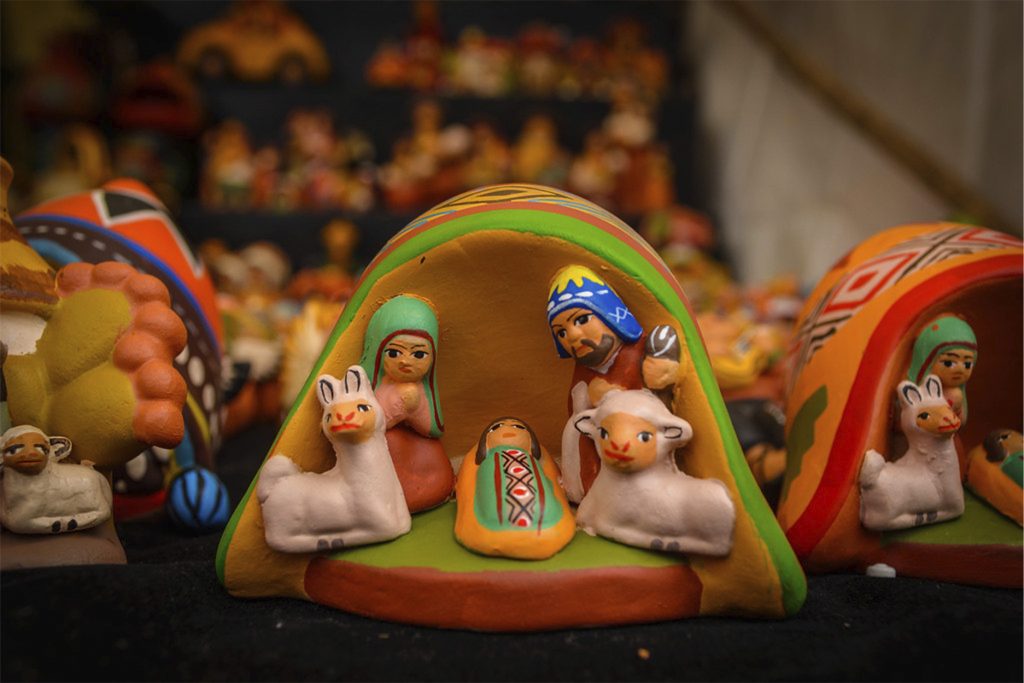
Unique Christmas Traditions in Cusco
Cusco, the former capital of the Inca Empire and the archaeological capital of the Americas, transforms in December. This vibrant city offers visitors a Christmas that fuses ancient Andean traditions with modern customs. Get ready to experience some truly unique moments:
Santurantikuy: A Fair That Connects Past and Present
Every December 24, Cusco’s main square transforms into the bustling Santurantikuy Fair, one of the most essential parts of Christmas in Cusco, Peru. The name comes from Quechua and means “the selling of saints”, perfectly describing its spirit—a great open-air market where art, faith, and Andean culture meet in a festive, family-friendly atmosphere.
The Santurantikuy has been celebrated since the 16th century. It began as a space for local artisans to sell religious figures before Christmas Eve. Over time, the fair became a grand showcase of Andean folk art, where artists from Cusco, Puno, Ayacucho, and other regions present ceramics, wooden carvings, and retablos—beautifully decorated wooden boxes that portray scenes from daily life, religious festivals, or historical events.
Today, the fair is recognized as National Cultural Heritage of Peru and stands as a symbol of Cusqueñan identity. While similar fairs exist in the Sacred Valley and nearby provinces, none rival its history or energy. Visiting the Santurantikuy means witnessing Andean creativity up close and feeling the true essence of Christmas in the heart of Cusco.
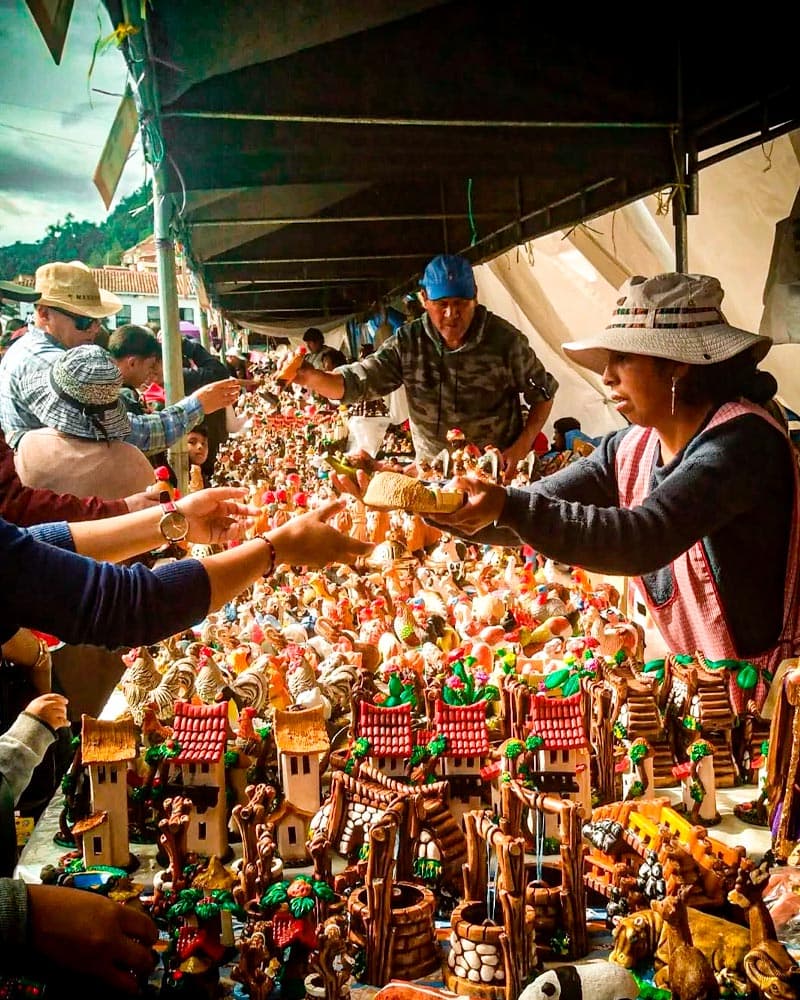
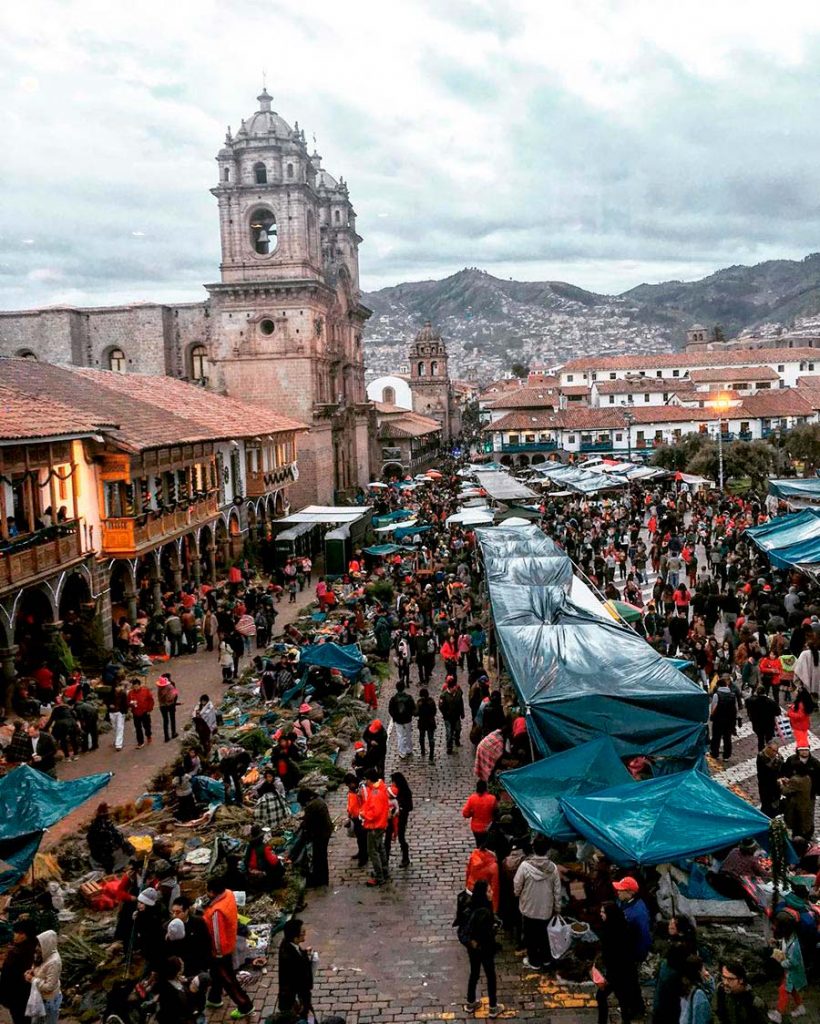
The Niño Manuelito
Among all the Christmas traditions in Cusco, none touch the heart quite like that of the Niño Manuelito, the most beloved figure in Cusqueñan nativity scenes. His story dates back to the 17th century, when Spanish priests taught biblical passages and often repeated the name Emmanuel, meaning “God with us.” The Andean people began calling him Manuel, and over time, devotion to the little Niño Manuelito was born—a symbol of love and faith for the people of Cusco.
Each December, his image appears in homes and at the Santurantikuy Fair, where artisans display sculptures inspired by him. He’s represented with Andean features—warm brown skin, rosy cheeks, and a gentle expression full of tenderness and closeness. Some portray him crawling, sitting, or lying down, symbolizing the human side of Jesus adapted to the heart of the Andes.
For Cusqueñans, the Niño Manuelito represents protection, hope, and prosperity. His presence illuminates homes and keeps alive the spirituality that gives meaning to Christmas in Cusco, Peru.
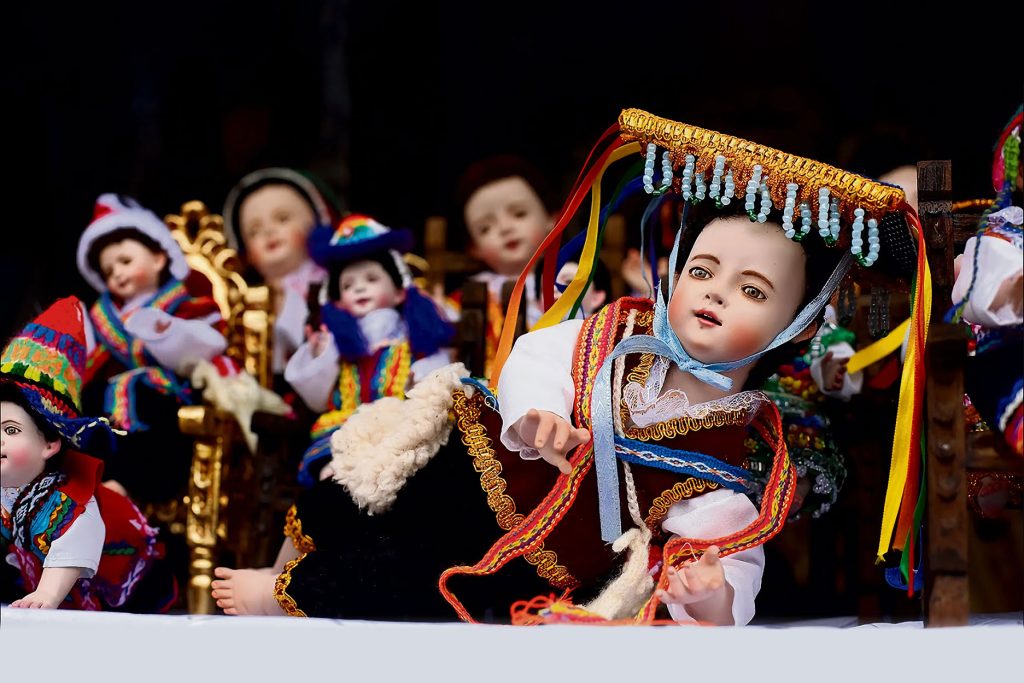
The Christ Child of the Thorn
The Niño de la Espina (“Child of the Thorn”) is one of the most beloved and representative images of Christmas in Cusco — a deeply Andean version of the Niño Manuelito. Created in 1975 by master artisan Antonio Olave Palomino, recognized as a Living Cultural Heritage of Peru, this sculpture reflects the love and empathy of the Andean people through a touching scene: the Child Jesus seated, a tear on his cheek, removing a thorn from his foot.
The inspiration comes from an ancient Andean legend about a young shepherd who, seeing his friend cry from the pain of a thorn, decided to pierce himself with another to share his suffering. This gesture of solidarity inspired Olave to create an image that embodies compassion, humanity, and divine tenderness. Its realism is remarkable: glass eyes and tears, condor-feather teeth, natural hair, and gold leaf details carved in wood.
Blessed by Pope John Paul II in 1985, the Niño de la Espina has become a central figure of Cusco’s folk art and one of the most sought-after creations during the Santurantikuy Fair. More than a sculpture, it represents the very heart of Christmas in the Andes — a celebration that unites faith, artistic beauty, and the spirit of solidarity that defines Cusco.
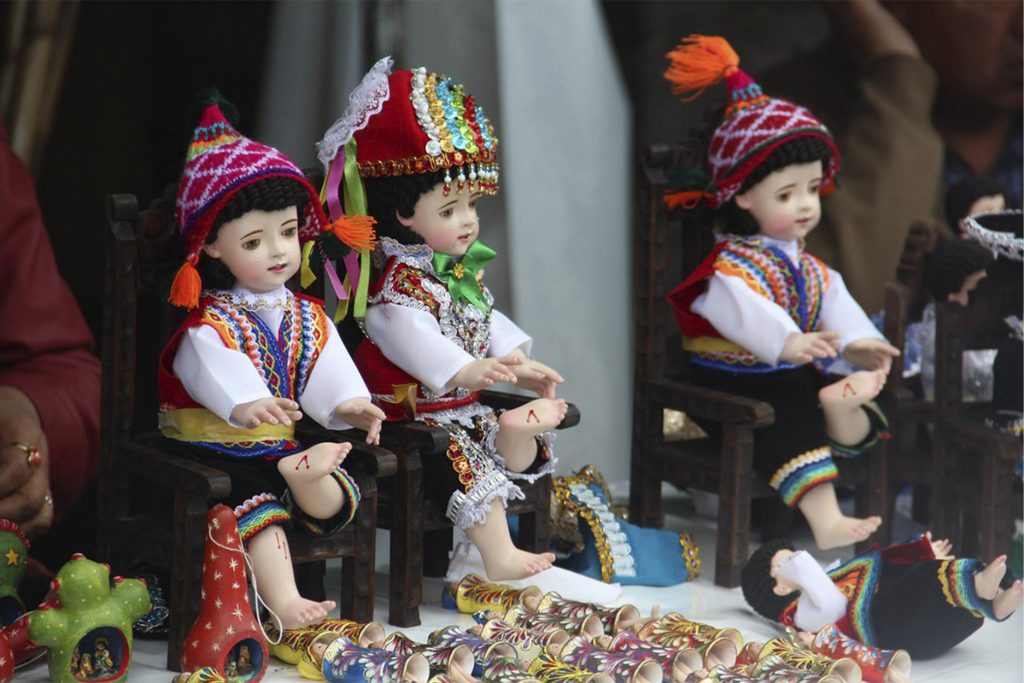
The Andean Nativity Scene
The Andean Nativity Scene is one of the most beautiful and authentic expressions of Christmas in Cusco. More than just a representation of the birth of Jesus, it reflects how Andean culture reinterpreted the Christian story through its own worldview.
Unlike traditional European nativity scenes, Cusqueñan nativity scenes recreate Andean landscapes—with moss, straw, herbs known as salvajina, miniature hills, and tiny rivers made with mirrors. What stands out most is how Mary, Joseph, and the Niño Manuelito are portrayed: dressed in traditional Cusco clothing, colorful woven fabrics, ponchos, hats, and sandals. Instead of the classic ox and mule, you’ll find cows, llamas, alpacas, condors, and Andean villagers bringing offerings to the Niño Manuelito, the central figure of every Cusqueñan Christmas.
You can find handmade Andean nativity scenes in the artisan workshops of San Blas or at Christmas fairs, made from ceramics, wood, stone, or retablo boxes. Prices vary depending on size and detail—small pieces start at around 20 soles, while large, masterfully carved nativities can reach 200 or 300 soles.
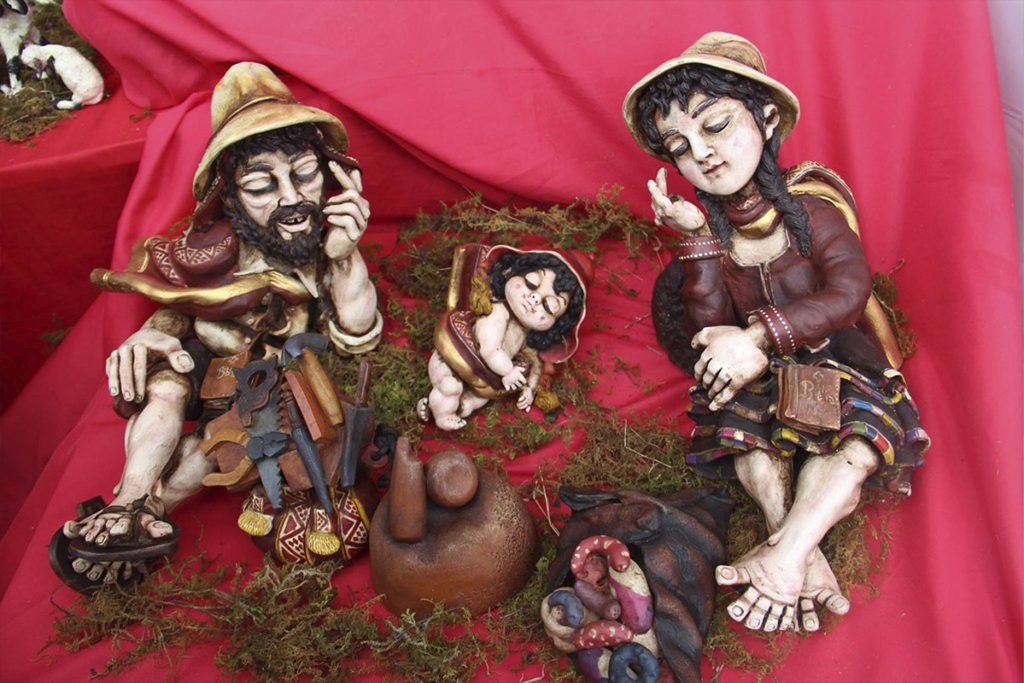
The Life-Sized Nativity Scene in the Main Square of Cusco
One of the highlights of Christmas in Cusco is the majestic life-sized nativity scene installed each year in the main square, a tradition that fascinates both locals and visitors. The distinctive long-necked figures of this nativity make it instantly recognizable.
This unique artistic style was created by the renowned sculptor Hilario Mendívil Velasco (1927–1977), from the traditional neighborhood of San Blas. Together with his wife, Georgina Dueñas, Mendívil developed this signature technique, inspired by the elegant necks of llamas and alpacas—animals sacred to the Andes. His long-necked saints and virgins symbolize grace, humility, and spiritual elevation.
Today, the Mendívil family, led by his daughter Juana Mendívil (recognized as “Amauta del Arte Popular Peruano”), continues this legacy. They are responsible for assembling the life-sized nativity in the main square, using natural Andean elements such as straw and herbs to build the manger. The result is a breathtaking fusion of Andean art and faith—a must-see for anyone spending Christmas in Cusco.
It’s worth noting that the main square’s nativity isn’t the only one in the city. The main squares of Cusco’s eight districts also feature their own nativity scenes and decorated trees, each with its own unique style. Over the years, this has evolved into a friendly, unspoken competition, where each district proudly expresses its creativity and identity through the Christmas spirit.
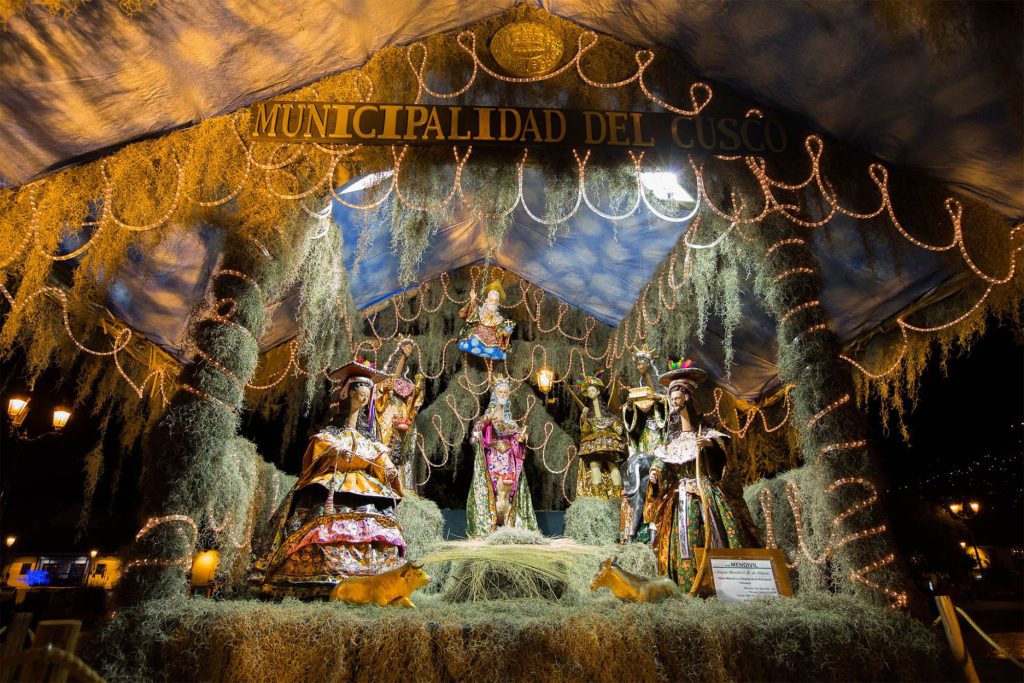
Life-Sized Nativity Scenes in Archaeological Sites
Imagine walking through Cusco’s lively streets when, suddenly, you come across an ancient Inca site—and inside it, a nativity scene with life-sized figures. This surreal experience captures the true essence of Christmas in Cusco: the perfect blend of Andean history and Catholic tradition.
The most impressive nativity scenes you can visit in the Historic Center of Cusco include:
- Qorikancha (Temple of the Sun): This imposing temple, once the most sacred in the Inca Empire and dedicated to the Sun God (Inti), becomes a stunning stage for a monumental nativity during Christmas. The contrast between ancient Inca stonework and the Christian display creates a profound and moving experience where past and present meet.
- Kusicancha (The Inca Palace): Meaning “Joyful House,” this archaeological site is located on Maruri Street, just a block from the main square. Believed to be the birthplace of Inca Pachacútec, it hosts a beautifully crafted life-sized nativity during Christmas, made using traditional local techniques.
Travel Tip: When visiting nativity scenes in Cusco’s squares, churches, and archaeological sites, take time to notice the clothing and small details in each display. Every element reflects the harmonious union between Andean culture and Catholic tradition. Use these moments to talk with locals, listen to their stories, and learn more about their living culture.
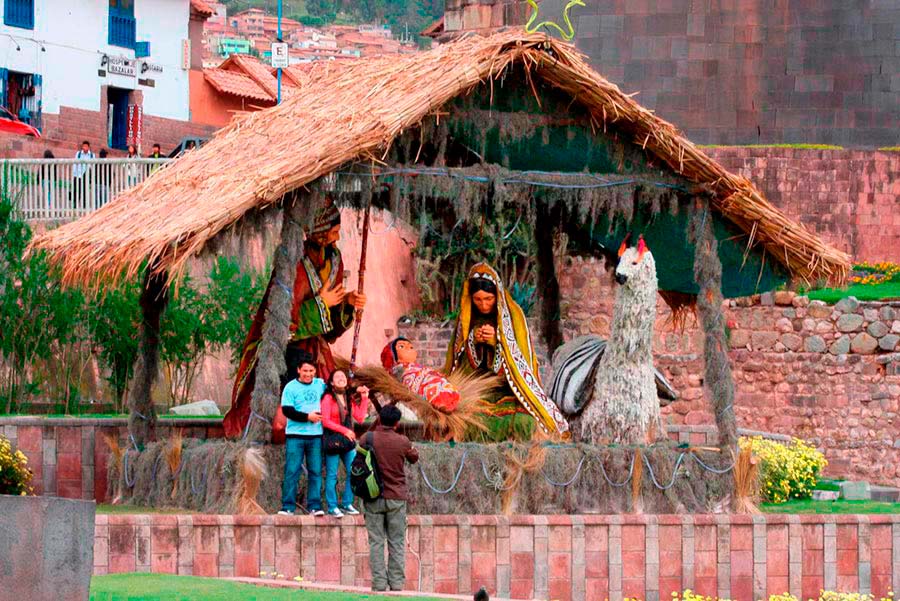
Midnight Masses (Misas de Gallo)
On the night of December 24, hundreds of Cusqueñans head to their local churches to celebrate the birth of the Niño Manuelito, also known as the Christ Child, during the famous Midnight Masses or Misas de Gallo. It’s a heartfelt tradition in which many families bring their own small image of the Niño so he can “hear” the Mass and receive the priest’s blessing—a gesture that symbolizes protection and renewed faith for each home.
The ceremony begins close to midnight, with hymns in Spanish and Quechua that fill the air with devotion and joy. The combination of lights, incense, and carols creates a unique atmosphere that blends the sacred with the Andean. When Mass ends, church bells ring across the city as fireworks light up the sky. Families return home with their blessed Niño Manuelito figures to share Christmas dinner, gifts, and gratitude for the year to come.
Travel Tip: The Midnight Masses in Cusco are open to everyone, so visitors are welcome to join. However, they draw large crowds, so it’s best to arrive at least 30 minutes before midnight to find a good spot. If you arrive later, don’t worry—the doors remain open, and you can still listen to the Mass from wherever there’s space.
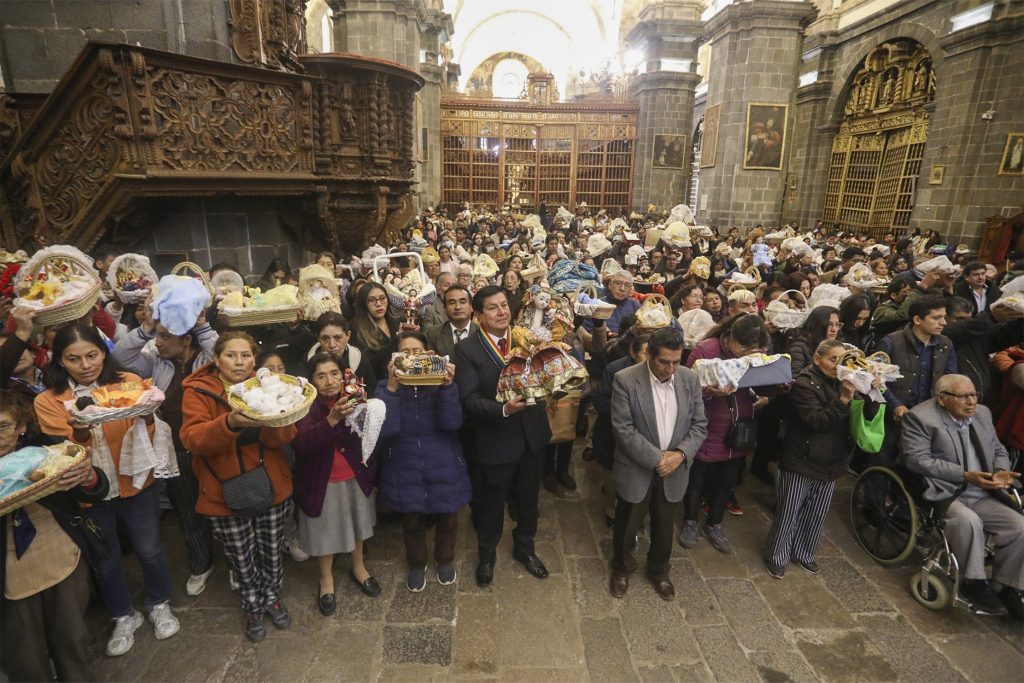
The Solidarity Hot Chocolate Gatherings
The solidarity hot chocolate gatherings, or chocolatadas solidarias, are one of the most touching and heartwarming traditions of Christmas in Cusco, Peru. Every December, churches, associations, businesses, and families come together to share joy with those who need it most. They offer cups of hot chocolate, panetón (Peruvian fruitcake), and small gifts in rural communities and working-class neighborhoods, spreading a message of unity and hope.
A beautiful example of this spirit is the initiative by Salkantay Trekking, whose team visits high-Andean communities each year to bring happiness and support to local children. During these gatherings, volunteers share games, carols, and special moments with local families. Bringing smiles and joy to others has become one of the most meaningful ways to experience Christmas in Cusco, reaffirming the city’s values of community, empathy, and gratitude.
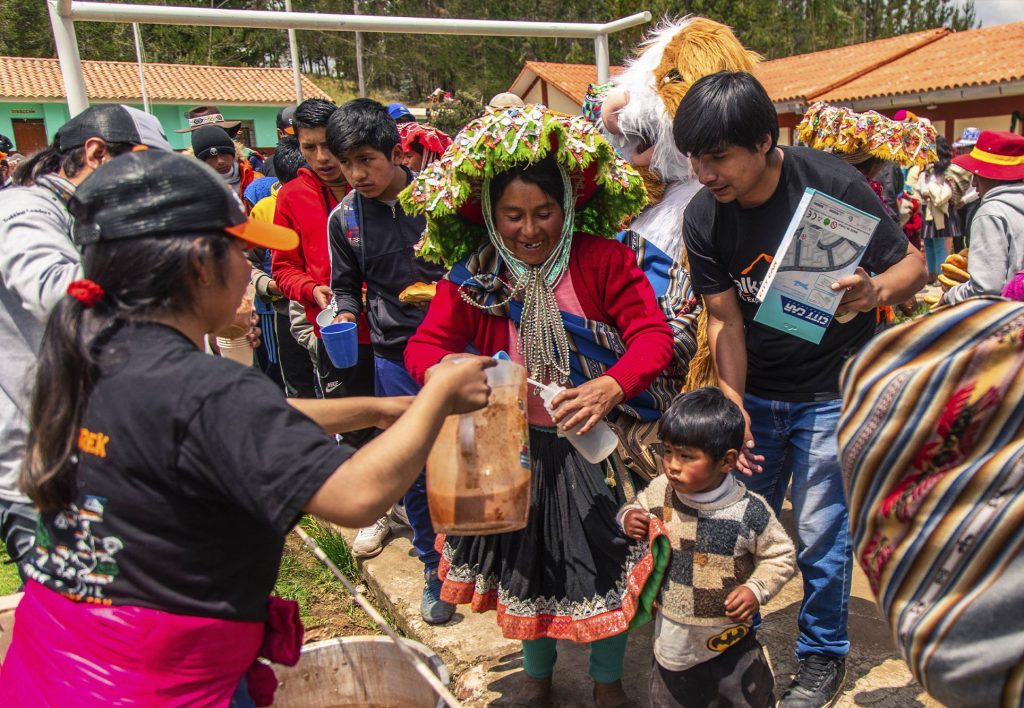
Christmas Carols in Quechua
One of the most charming traditions of Christmas in Cusco is the singing of carols in Quechua, a beautiful fusion of Andean melodies and Christmas spirit. In churches, squares, and schools, choirs perform songs that blend traditional instruments such as the quena (flute) and zampoña (panpipes). Every note carries joy and faith, filling the air with an energy that only Cusco can create.
Listening to carols in Quechua means feeling the living identity of the Andean people. The lyrics tell the story of Jesus’ birth in the ancestral language, connecting new generations with their roots. For visitors, it’s a unique and moving experience that shows how music unites cultures and keeps the essence of Christmas in Cusco alive.
In Cusco, there isn’t a single website that lists all the city’s cultural and artistic events, but there are several reliable sources you can check if you love living culture. We recommend visiting the official websites of the Municipal Theater of Cusco or the municipalities in Cusco. There you’ll find updated information about festivals, fairs, exhibitions, and performances that can make your Christmas experience even more special.
Travel Tip: Be aware that some fake or duplicate pages appear on social media. Always make sure the accounts you visit are official and up to date—check posting frequency and user comments. Tripadvisor can also be a great place to look for verified references and reviews.
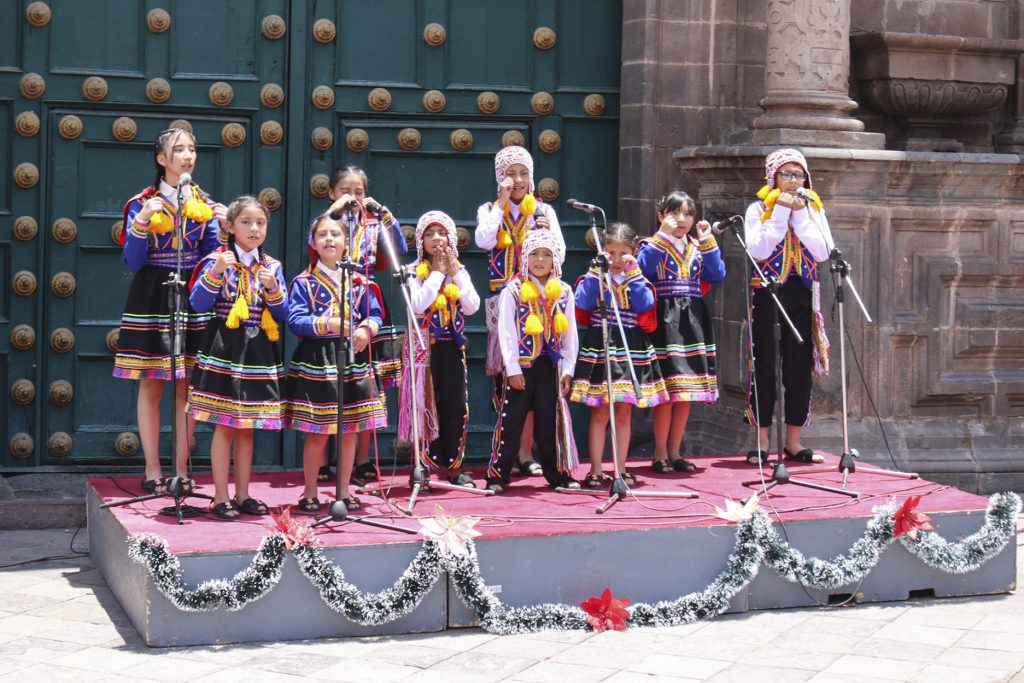
Live Nativity Scenes
During Christmas in Cusco, Peru, live nativity scenes bring color and emotion to the squares of towns and communities. Children and young people reenact the birth of the Niño Manuelito, wearing traditional clothing and accompanied by animals such as llamas, sheep, and donkeys. This tradition blends Christian faith with rural Andean customs, becoming a genuine expression of local culture.
These performances are not limited to churches—they’re also staged in schools and neighborhoods, where families gather to enjoy the show. Music, Quechua carols, and local offerings make each reenactment unique. This custom keeps Cusco’s identity alive and reminds everyone that Christmas can be celebrated with simplicity, joy, and faith.
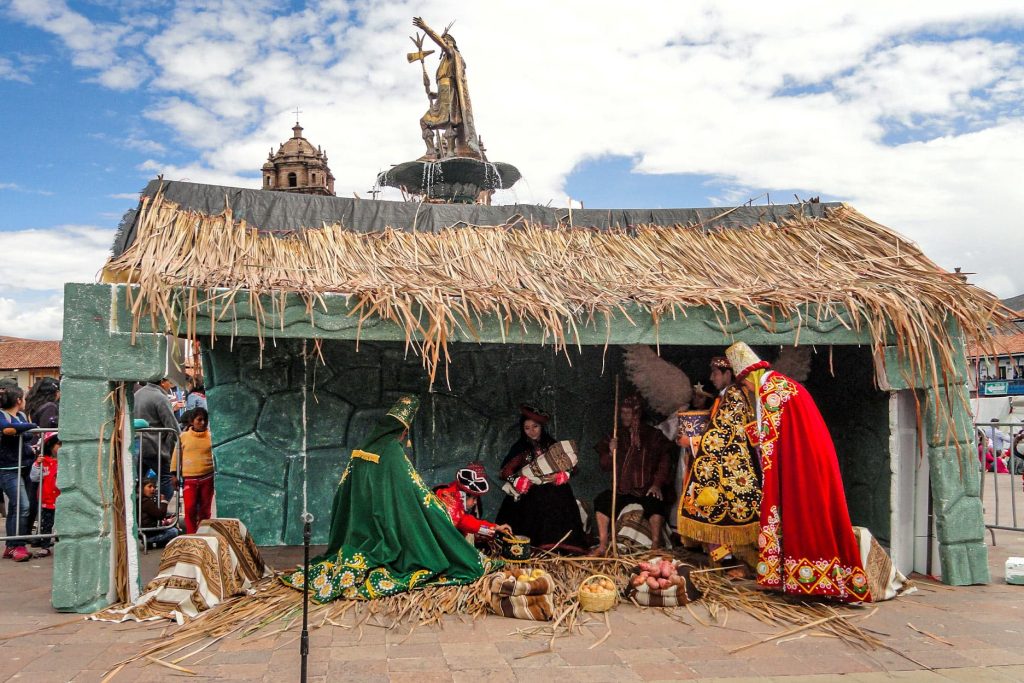
Visiting the Seven Churches
During Christmas in Cusco, Peru, many families and visitors keep a beautiful tradition alive: touring the seven churches of the historic center to admire the nativity scenes lovingly prepared in each temple. The most visited include the Cusco Cathedral, Church of the Compañía de Jesús, San Blas, Santo Domingo (Qorikancha), San Francisco, La Merced, and San Cristóbal. Each one displays a unique nativity scene that combines folk art, devotion, and Andean symbolism.
This practice originated during Holy Week, when worshippers visited seven temples as an act of reflection and faith. Over time, Cusqueños began doing the same at Christmas—but with a different purpose: to visit churches, admire the nativity scenes, give thanks for the year that’s ending, and share time with family. Today, this route has become a wonderful way to celebrate unity, faith, and the artistic beauty that fills Cusco’s streets with light each December.
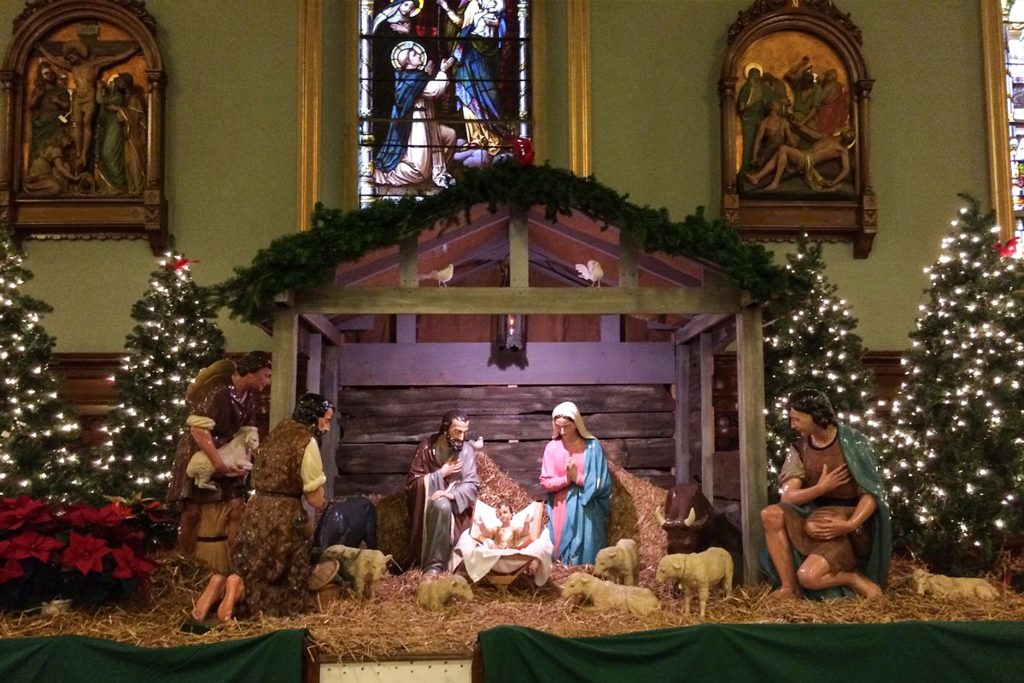
The Three Kings’ Day (Bajada de Reyes)
The Bajada de Reyes, or Three Kings’ Day, marks the end of the Christmas festivities in Cusco, Peru. Every January 6, families take down their nativity scenes and gather to remember the arrival of the Three Wise Men at the manger. It’s a joyful day filled with music, food, and reunions—a time to give thanks for the year that’s ending and to ask for prosperity in the new one.
In many Cusqueñan communities, the date is celebrated with processions, traditional dances, and local fairs. People often take the opportunity to renew decorations or exchange symbolic gifts. The Bajada de Reyes extends the Christmas spirit just a little longer, proving that in Cusco, faith, tradition, and happiness walk hand in hand even after the holidays.
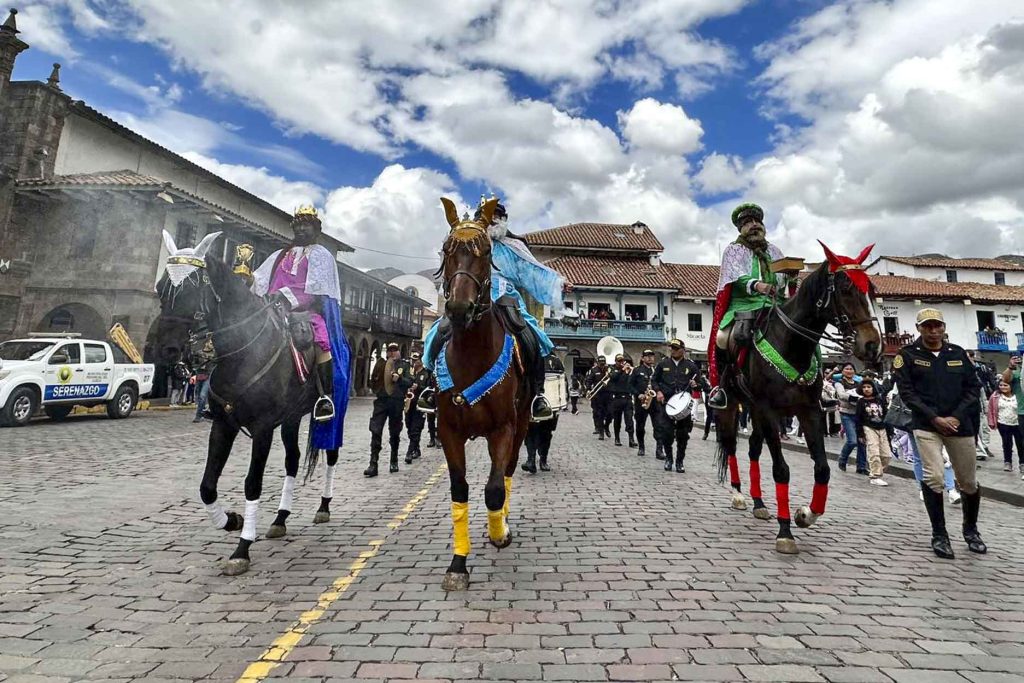
Traditional Christmas Cuisine in Cusco, Peru
Christmas in Cusco, Peru is also celebrated through its flavors. Each family lovingly prepares a dinner that blends the best of Andean tradition with modern influences, creating a unique experience that brings everyone together around the table.
On Christmas Eve, the aroma of roasted meats and hot chocolate fills Cusqueñan homes. Roast turkey is often the main dish, marinated with Peruvian spices and chili peppers for a rich, flavorful taste. However, the favorite for many families remains the Cusqueñan roasted pork (lechón al horno)—pork seasoned with garlic, cumin, ají panca, and local herbs, roasted slowly until tender and golden. In some homes, other meats like roast chicken or even the traditional roast guinea pig (cuy) are served, depending on family custom.
Typical sides include morayas (dehydrated potatoes), tamales or humitas made from corn dough wrapped in corn or banana leaves, and arroz a la jardinera (vegetable rice) that adds color and flavor to the meal. Fresh salads—often with fruit—balance the dishes perfectly. In some families, before midnight, it’s traditional to enjoy a warm chicken soup (caldo de gallina) to stay cozy while waiting for Christmas to arrive on Cusco’s chilly nights.
Dessert brings the classic panetón with hot chocolate, an unmissable duo in any Peruvian Christmas celebration. Others enjoy ponche cusqueño, a sweet, steaming drink made with milk, almonds, beans, or even a touch of pisco. These comforting flavors, combined with the festive family atmosphere, make Christmas in Cusco a celebration lived not only with the heart but also with the palate.
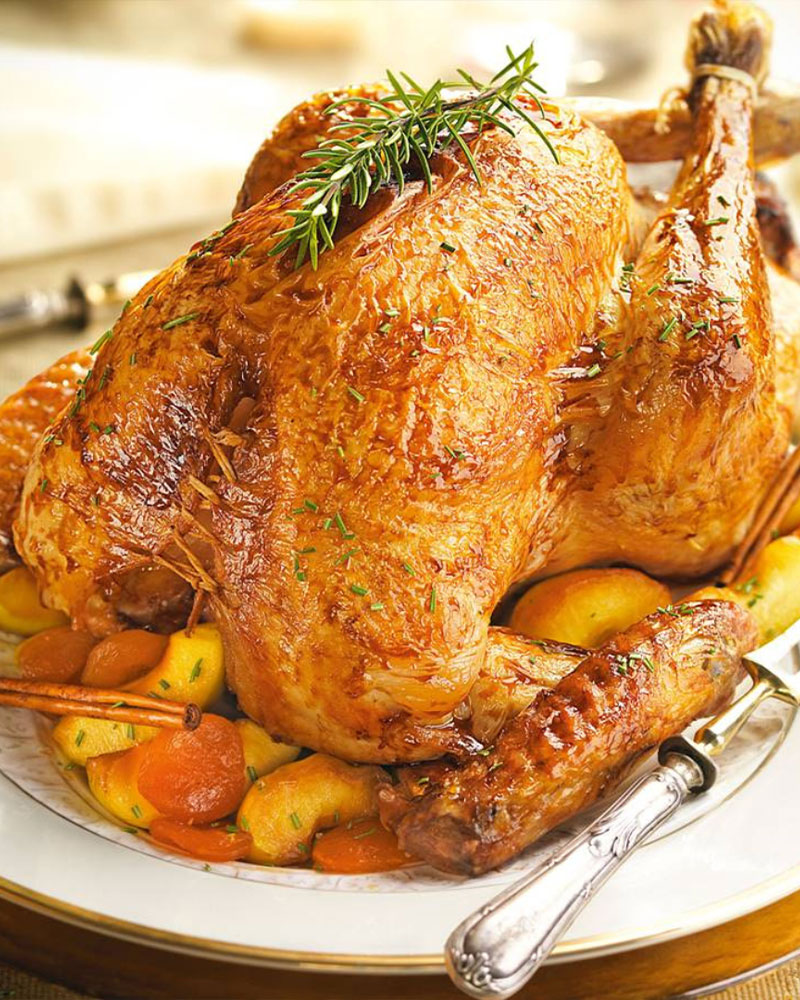
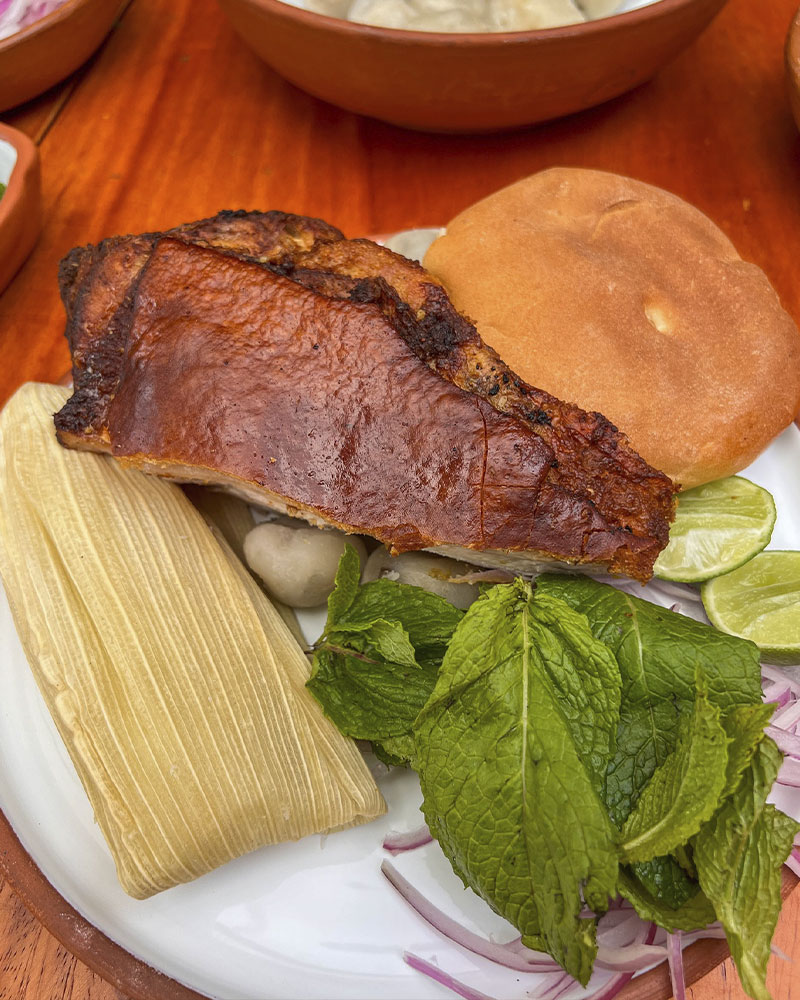
Is December a Good Time to Visit Cusco, Peru?
In December, Cusco enters its rainy season, but that doesn’t mean your trip can’t be special. The weather combines frequent showers—mainly in the afternoons—with occasional sunny breaks. Daytime temperatures range between 60.8°F and 68°F (16°C to 20°C), while nights can drop to around 41–45°F (5–7°C).
Although the air can feel cool and damp during rain, this contrast makes the landscape greener and more vibrant. Bringing warm clothing for the evenings, a rain jacket, and comfortable waterproof shoes will help you enjoy your trip comfortably. With the right planning, December becomes a magical month to experience Christmas in Cusco, filled with color, warmth, and celebration.
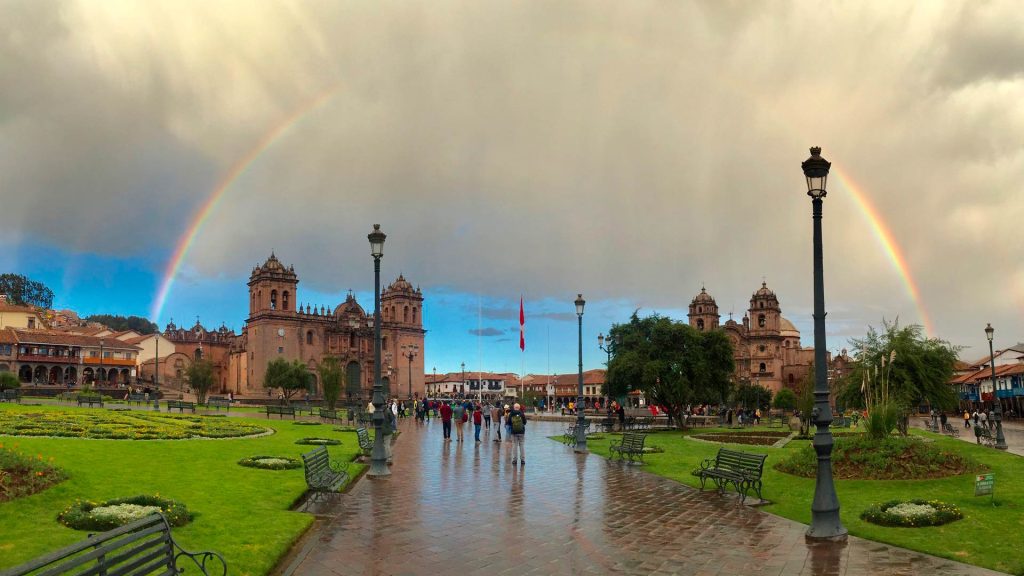
Christmas at Machu Picchu
Celebrating Christmas in Cusco, Peru takes on an entirely new meaning when you include Machu Picchu in your itinerary—a perfect blend of Andean spirituality and the majesty of the ancient Inca Empire. This experience combines the magic of the holidays with the sacred energy of the citadel, creating memories that will last a lifetime.
In December, the weather in Machu Picchu is humid with light rains, but you’ll also enjoy moments of sunshine that illuminate the mist-covered mountains, creating dreamlike scenery. Visiting Machu Picchu at Christmas allows you to experience the site with fewer tourists than in the high season, making your visit more peaceful and spiritual. It’s the perfect way to end the year with gratitude—surrounded by energy, culture, and natural beauty.
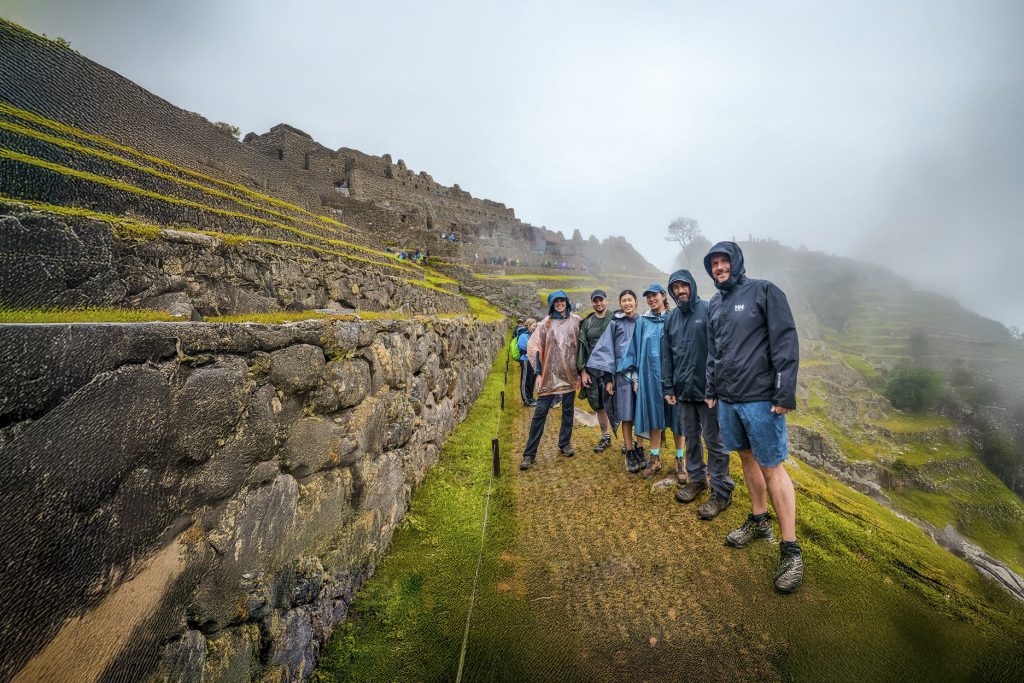
Tourist Destinations to Enjoy Christmas in Cusco, Peru
Beyond Machu Picchu, Cusco at Christmas offers a wide variety of destinations that combine history, tradition, and breathtaking landscapes. One favorite is the Sacred Valley of the Incas, where towns like Pisac, Urubamba, and Ollantaytambo celebrate with colorful fairs, dances, and church services. The green mountains and flower-filled fields create an ideal setting for travelers seeking to connect with nature without straying far from Andean traditions.
Within Cusco itself, the San Blas neighborhood comes alive with open workshops, warm lights, and artisans showcasing their Christmas creations. It’s also worth visiting Tipón, Maras, Moray, and Chinchero, where Christmas is celebrated in close-knit communities. Wherever you go, December in Cusco is filled with faith, art, and hospitality, offering a unique experience for every traveler.
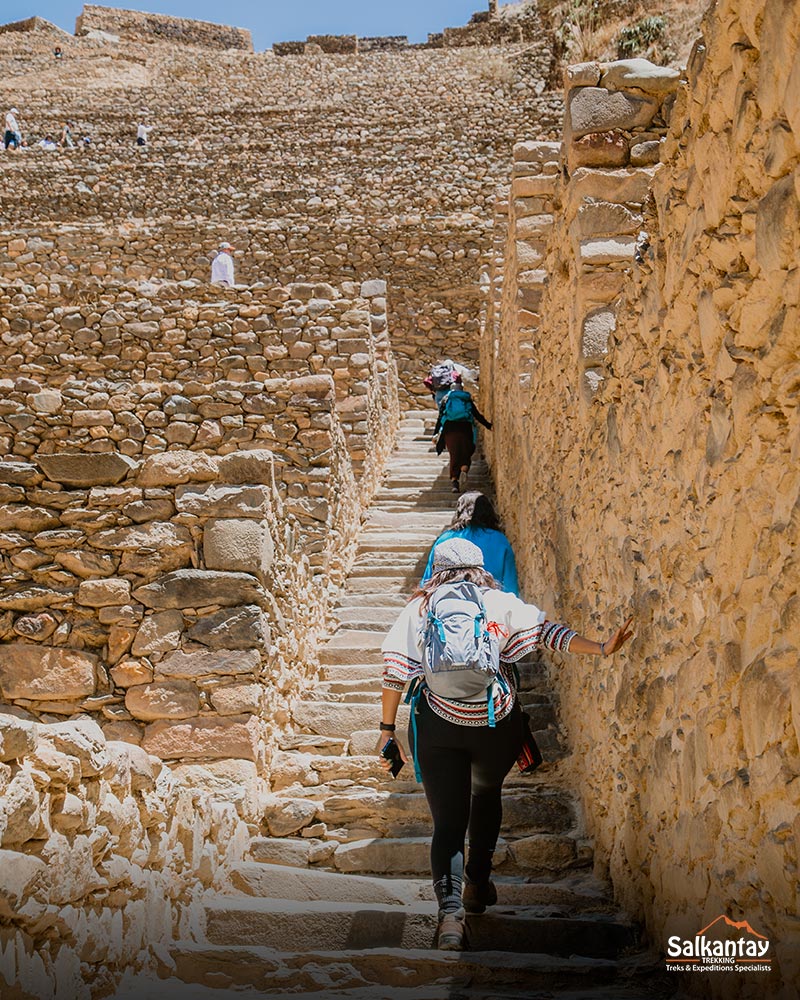
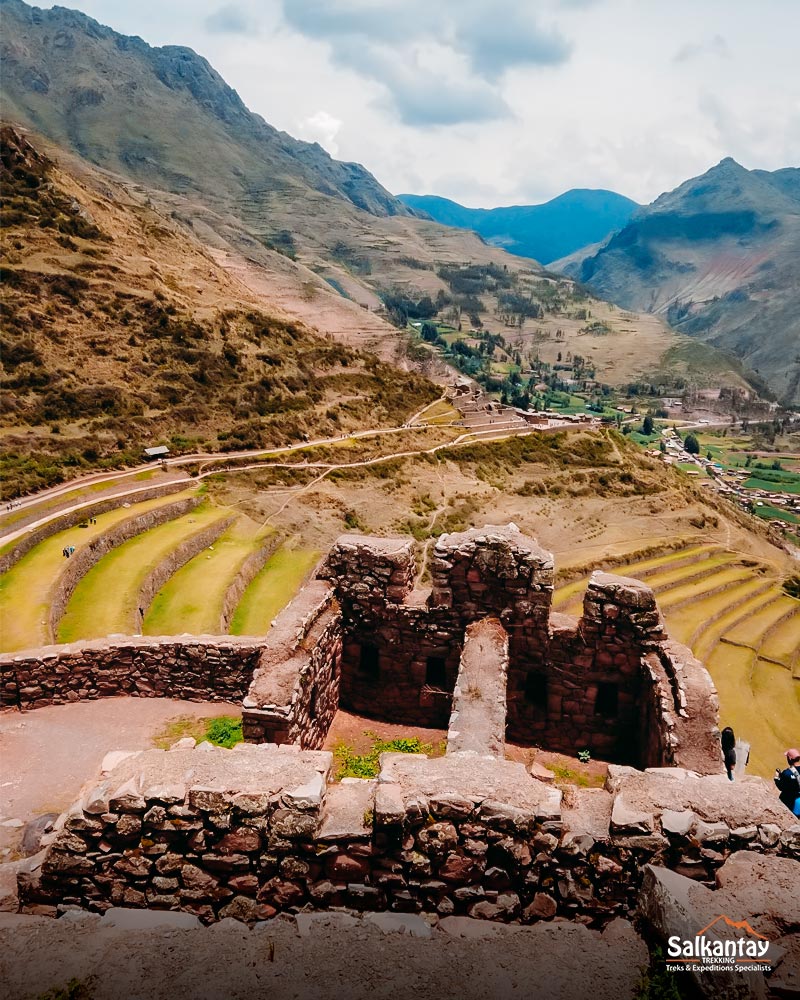
Accommodations in Cusco During the Christmas Season
During Christmas in Cusco, the city fills with visitors who come to enjoy its markets, festivities, and warm holiday atmosphere. Because of this, it’s important to book your accommodation in advance, especially if you plan to travel between December 20 and 31, when demand for hotels is at its peak.
Cusco offers a wide range of options for every type of traveler—from boutique hotels in colonial mansions to family-run guesthouses and budget-friendly hostels with mountain views.
If you want to fully experience the Christmas spirit, the best option is to stay in the Historic Center, near the main square, where you’ll be within walking distance of the Santurantikuy Fair, the Midnight Mass, and the main churches. For a quieter stay, consider the San Blas neighborhood, known for its artistic charm and panoramic views of the illuminated city.
Many hotels and lodges offer special Christmas Eve dinners, live music, and holiday-themed activities. Some even collaborate with local communities in solidarity hot chocolate events or artisan fairs, allowing you to experience a more authentic and meaningful Cusqueñan Christmas.
Accommodation Options and Approximate Prices
Prices vary depending on the type of lodging, but it’s worth noting that luxury hotels often host exclusive Christmas Eve dinners and special menus.
- Luxury Hotels (4–5 stars):
Properties such as the JW Marriott, Palacio del Inka, Hilton Garden Inn or Wyndham Costa del Sol offer premium experiences, often located in restored convents or colonial palaces. Services may include oxygen treatments and spas.
Average Price: From S/ 300 to over S/ 1,200 per night. - Mid-Range Hotels (3–4 stars):
These balance comfort and value—examples include Sonesta Hotel, Novotel, and Tierra Viva. Most include breakfast and Wi-Fi.
Average Price: From S/ 170 to S/ 400 per night. - Hostels and Guesthouses:
Perfect for budget travelers or solo adventurers. They offer affordable rates and a social atmosphere.
Average Price: From S/ 30 to S/ 90 per night, depending on whether the room is shared or private.
Travel Tip: Want to learn about the best neighborhoods and lodging options based on your travel style? Check out our blog “Where to Stay in Cusco?”, where you’ll find detailed recommendations, tips, and options for every budget.
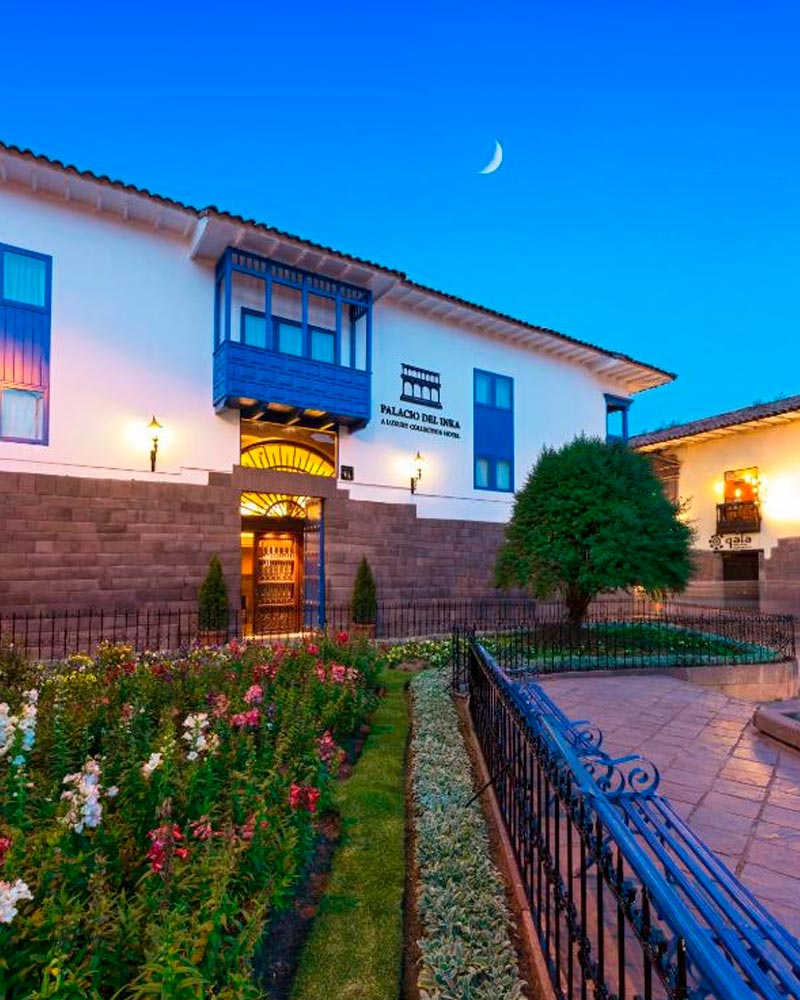
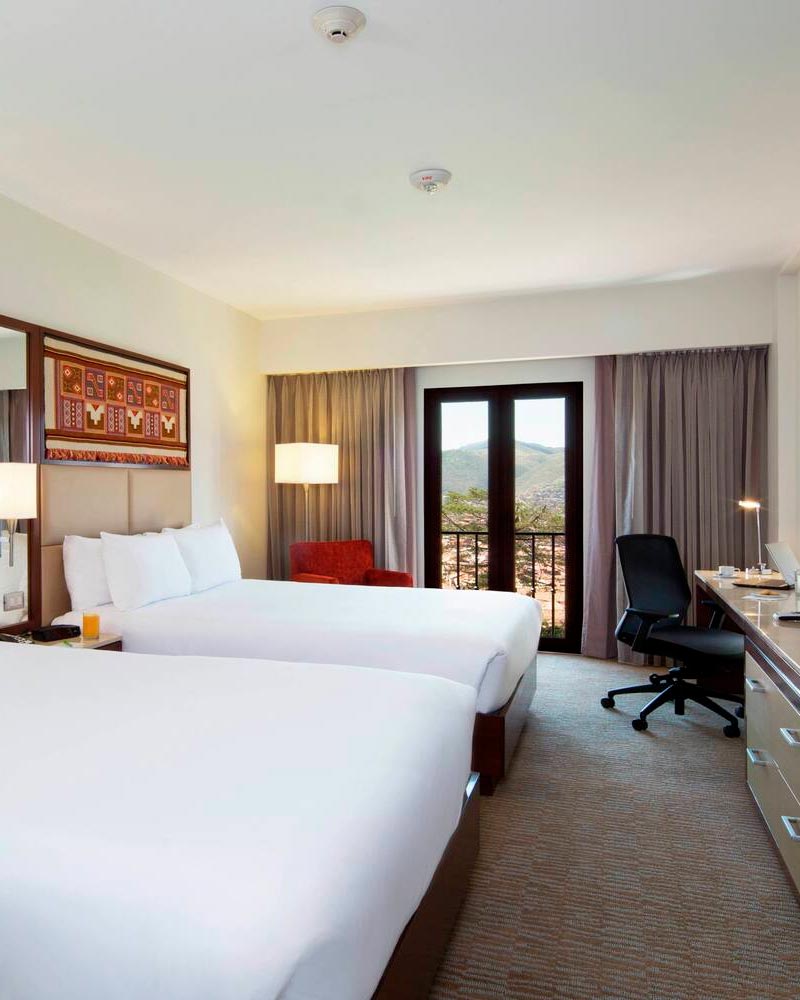
Christmas Calendar in Cusco
- December 24 – Santurantikuy Fair:
Held in the main square, this traditional art fair draws huge crowds of locals and tourists. - December 24 – Midnight Mass (Misa de Gallo):
Celebrated at Cusco’s Cathedral and other main churches at midnight, this open-to-the-public ceremony marks one of the most spiritual moments of Christmas Eve. - December 25 – Christmas Day:
Families gather for festive meals, music, and heartfelt reunions. While the city center feels calmer, the joyful Christmas spirit still fills the air. - December 31 – New Year’s Eve:
The year ends with joy and Andean rituals in the main square. Locals and travelers come together to welcome the New Year with music, fireworks, and traditions—like walking around the square seven times to bring good luck. - January 6 – Epiphany (Three Kings’ Day):
This marks the end of the Christmas season. Families attend mass in major churches, take down their nativity scenes, and remove festive decorations.
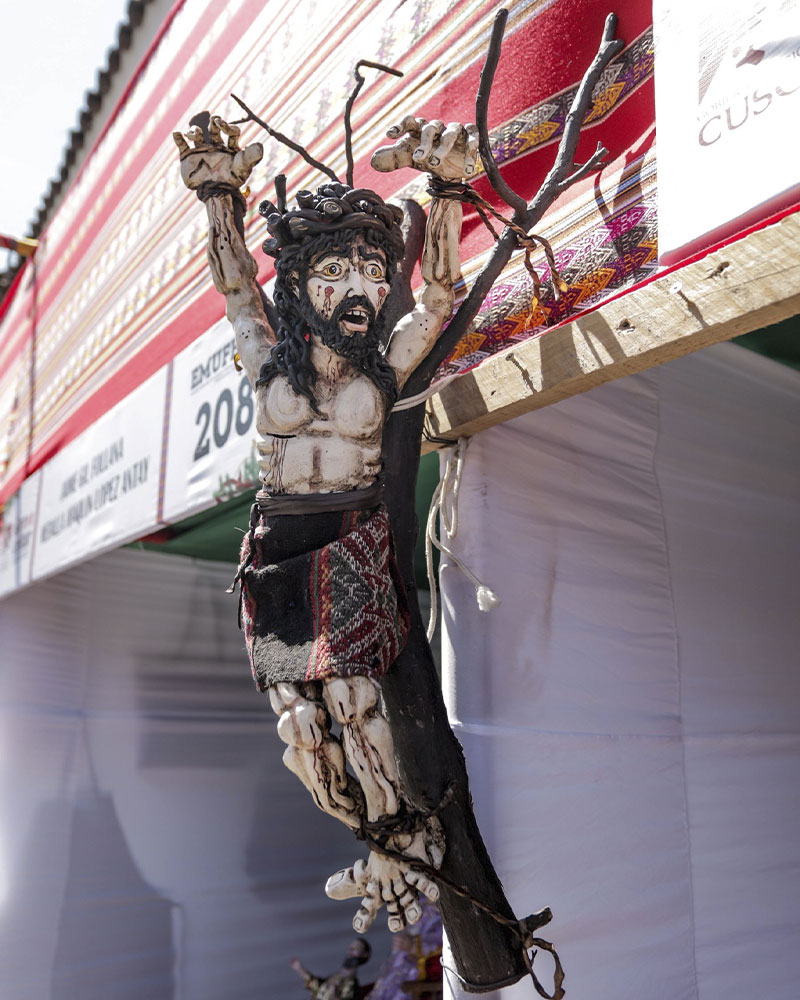
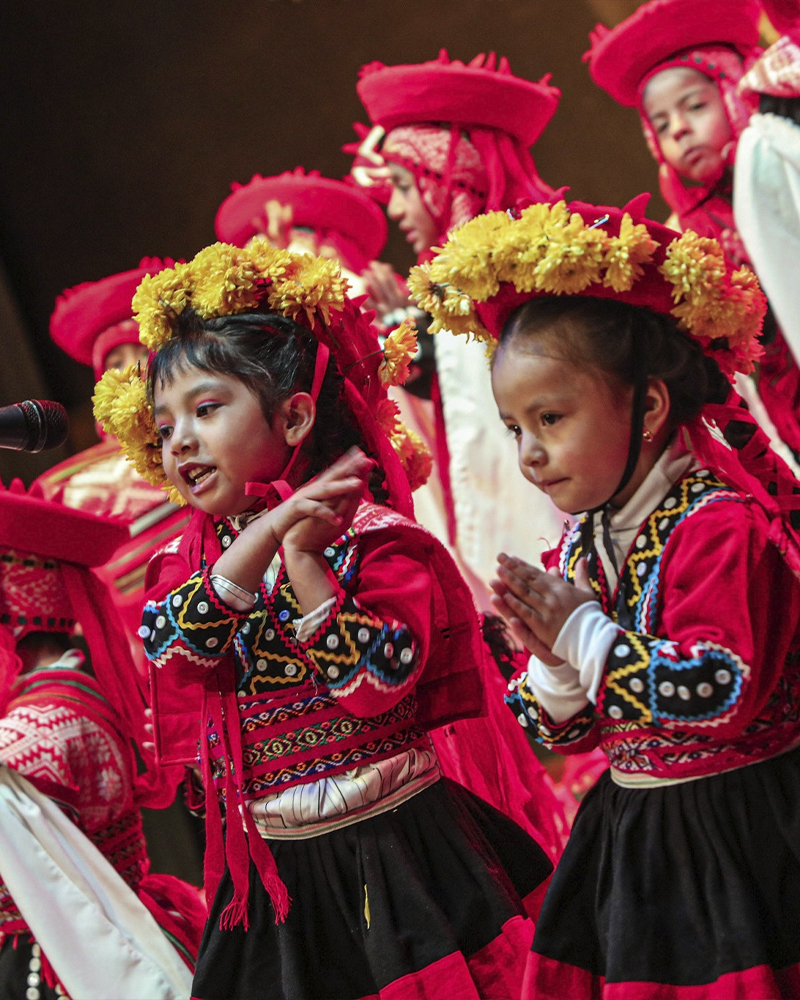
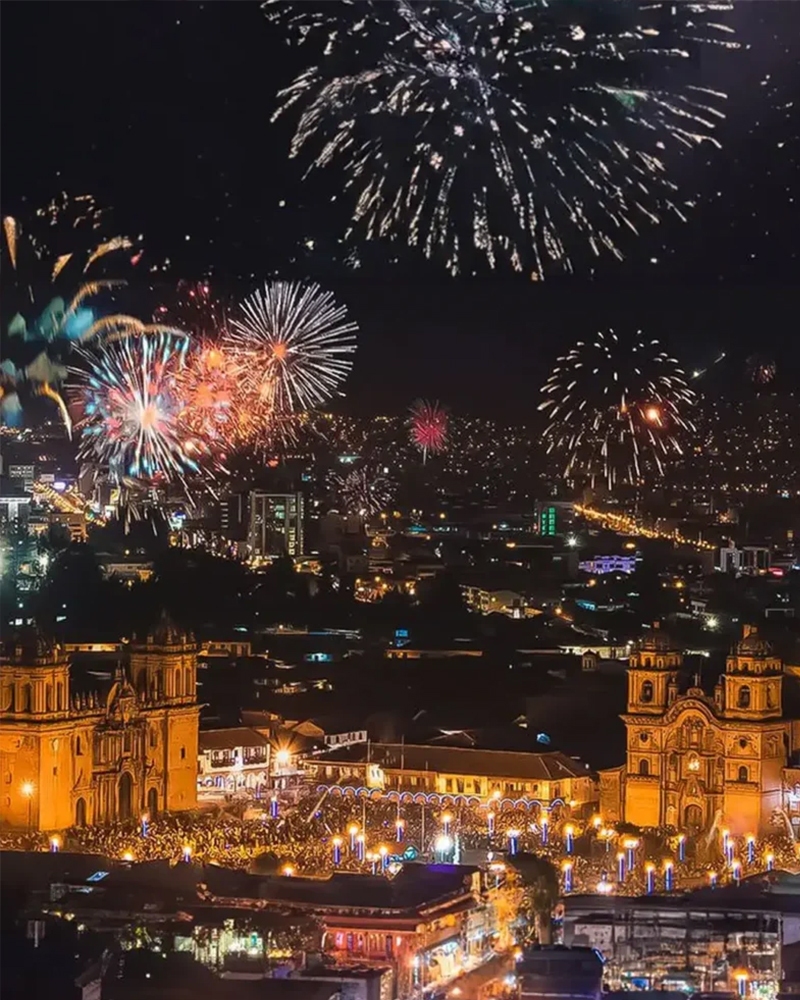
Tips for Experiencing Christmas in Cusco, Peru
- Prepare for the Andean weather: December in Cusco brings rain with moments of sunshine. Pack warm layers, a rain jacket, and comfortable shoes. Nights can get cold, especially during outdoor celebrations in squares or temples.
- Celebrate Christmas Eve like a local: On December 24, visit the Santurantikuy Fair in the main square and attend the Midnight Mass (Misa de Gallo). These moments capture Cusco’s spirit of faith, art, and tradition.
- Visit the churches: Follow the Cusqueñan custom of touring temples like the Cathedral, San Blas, and Qorikancha. Each one features unique nativity scenes rich in Andean symbolism.
- Join a “chocolatada solidaria”: Take part in a community hot chocolate event where neighbors gather to share gifts with children in need. It’s a beautiful way to experience the true meaning of Christmas—kindness and generosity.
- If you are invited to a Christmas dinner at someone’s home, remember that Cusco families are very traditional and welcoming. It is customary to bring a dish or a drink to share as a token of gratitude and courtesy.
- Support local art: Buy handcrafted Andean nativity scenes or ceramics made from clay, stone, or wood. These unique souvenirs help sustain Cusqueñan artisan families.
- Enjoy Christmas carols in Quechua: Listen to or join local choirs performing in squares and churches. Their ancestral language and melodies fill the air with magic.
- Celebrate with an open heart: More than just a holiday, Christmas in Cusco, Peru, is a cultural and spiritual experience. Embrace every detail—the warmth of its people, the peace in its mountains, and the joy that fills every corner of the city.
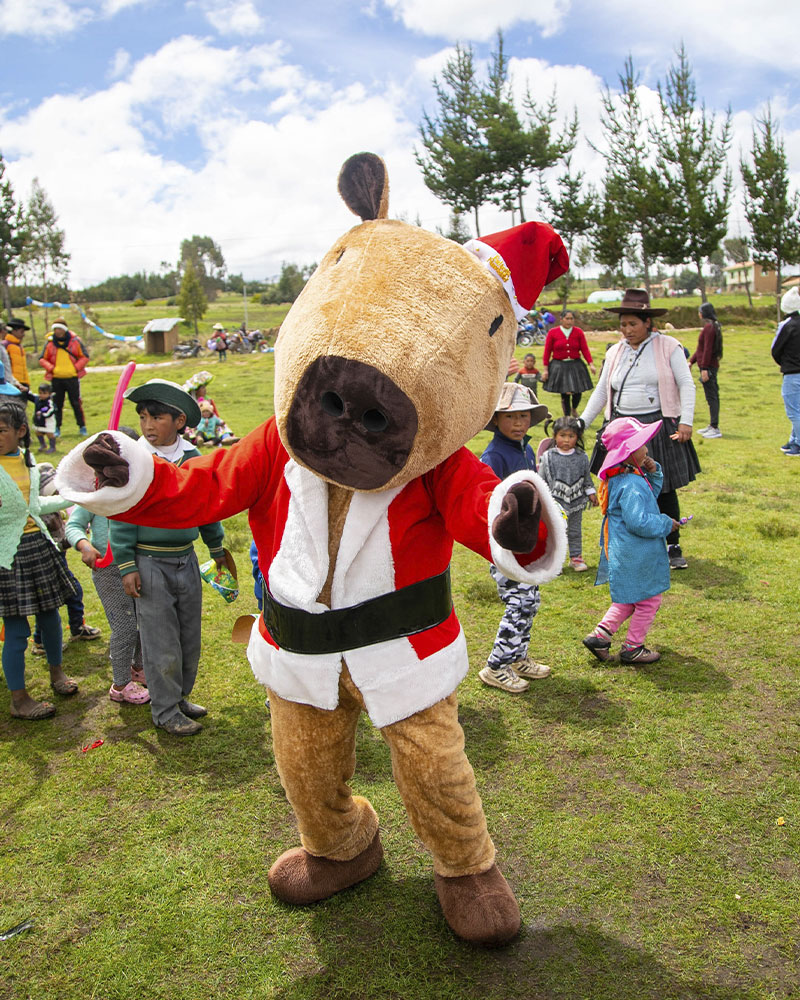
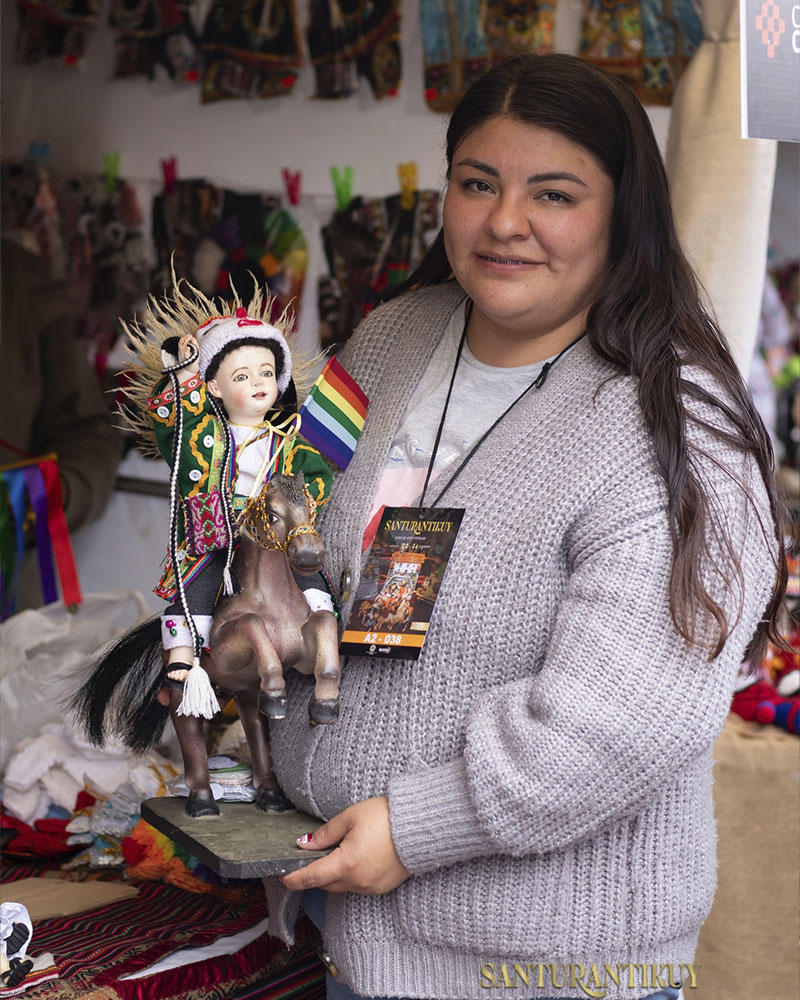
Final Reflection
Peru has always been a welcoming destination—warm, vibrant, and full of heart—and this spirit shines even brighter during Christmas in Cusco. Here, the holiday isn’t just celebrated—it’s felt. During this season, the mountains seem to embrace the city, and the Christmas spirit unites families and communities in an atmosphere of peace, joy, and tradition.
If you’re looking for an experience that connects you to something more profound—where spirituality meets art and tradition—Cusco awaits you this December. Discover how the magic of Christmas blends with the soul of the Andes, filling not only the streets with color but also the hearts of everyone who celebrates it.
This Christmas, explore Cusco with Salkantay Trekking. Discover the region’s most iconic destinations and experience a truly unique holiday celebration.
Book your Christmas adventure with us today!
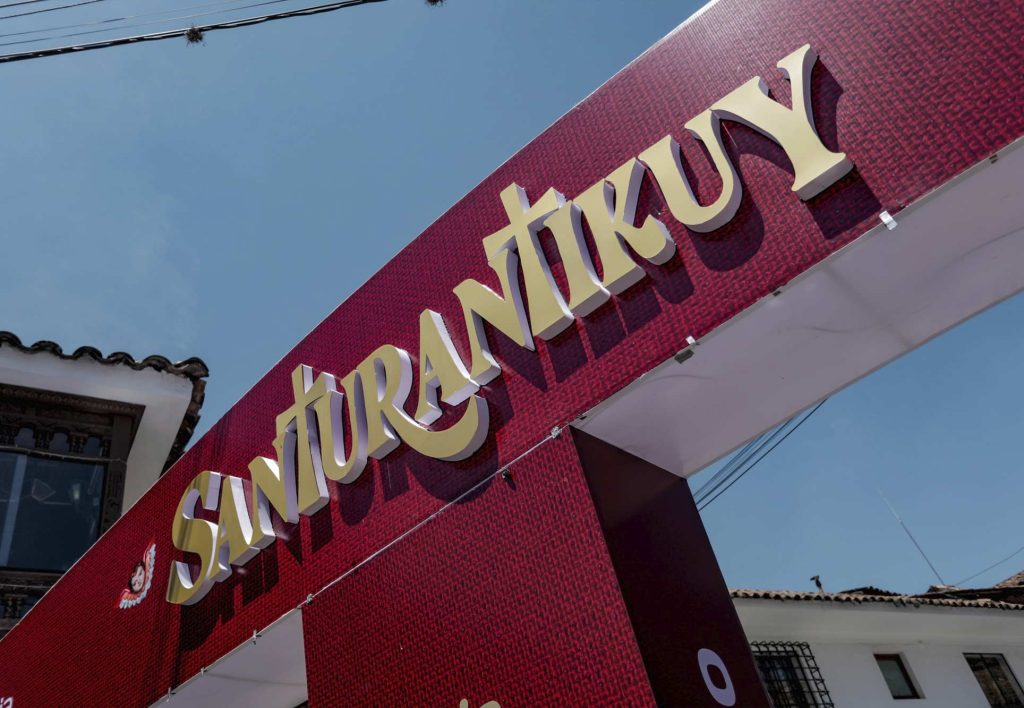
Frequently Asked Questions
1. How is Christmas celebrated in Cusco, Peru?
Christmas in Cusco is celebrated with a unique blend of Catholic faith and Andean traditions. The streets of the historic center fill with lights, markets, music, and handmade nativity scenes. On December 24, the famous Santurantikuy Fair takes place, and families attend Midnight Mass before sharing a festive dinner featuring roast pork (lechón), panetón, and hot chocolate.
2. When is the Santurantikuy Fair held?
The Santurantikuy Fair takes place every December 24 in Cusco’s main square. It’s one of the most anticipated events of the year, bringing together artisans from across the region who offer Niño Manuelito figures, Andean-style nativity scenes, retablos, and Christmas decorations.
3. What Christmas traditions are typical in Cusco?
Some of the most iconic customs include visiting the seven churches, attending solidarity hot chocolate gatherings, listening to carols in Quechua, shopping at the Santurantikuy Fair, and preparing Andean-style nativity scenes with figures dressed in traditional Cusqueñan clothing.
4. What’s the weather like in Cusco during December?
November marks the beginning of the rainy season in Cusco. Days are usually mild with sunny intervals and rainy afternoons. Temperatures range from 60.8°F to 68°F (16°C–20°C) during the day and drop to around 41–45°F (5–7°C) at night. It’s best to dress in layers, bring a rain jacket, and wear comfortable shoes.
5. What places should I visit in Cusco during Christmas?
Beyond the historic center, you can visit Machu Picchu, the Sacred Valley of the Incas, Maras, Moray, and Chinchero, where local communities also celebrate with fairs, music, and traditional dances.
6. Who is the Niño Manuelito, and why is he important in Cusco?
The Niño Manuelito is Cusco’s representation of the baby Jesus. His name comes from Emmanuel, meaning “God with us.” He is the central figure in Andean nativity scenes and symbolizes peace, faith, and hope during the Cusqueñan Christmas season.
7. What is eaten at Cusco’s Christmas dinner?
The traditional dish is roast pork (lechón al horno), often served with tamales, salads, and panetón with hot chocolate. In Andean communities, people also drink chicha and share local products such as corn, potatoes, and seasonal fruits.
8. Is it worth visiting Cusco at Christmas?
Absolutely! Cusco combines history, art, spirituality, and living culture. Although December is part of the rainy season, the festive atmosphere and local traditions make it one of the most magical times of the year to visit the city.
You Might Also Like:
- Christmas and New Year’s in Cusco: An Unforgettable Experience in the Peruvian Andes
- Santurantikuy in Cusco: Andean Christmas, a meeting of traditions and spirituality
- New Year in Machu Picchu
- What to expect and how to prepare for the Rainy Season in Cusco, Peru?
- Where to Stay in Cusco?
- Where to eat in Cusco 2025, the best of Cusco


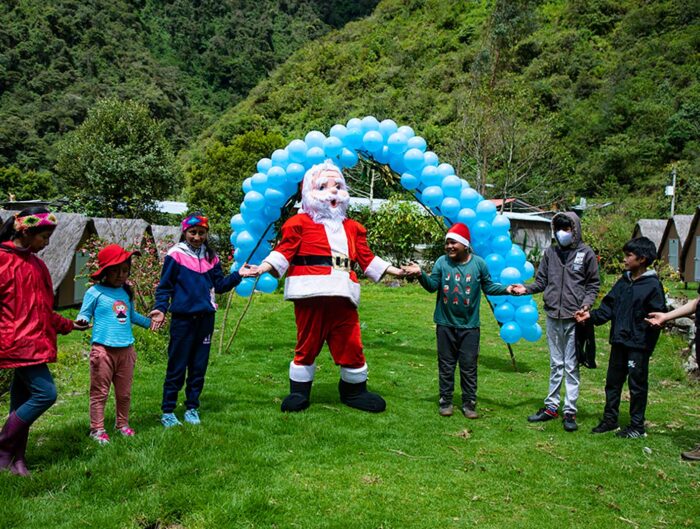
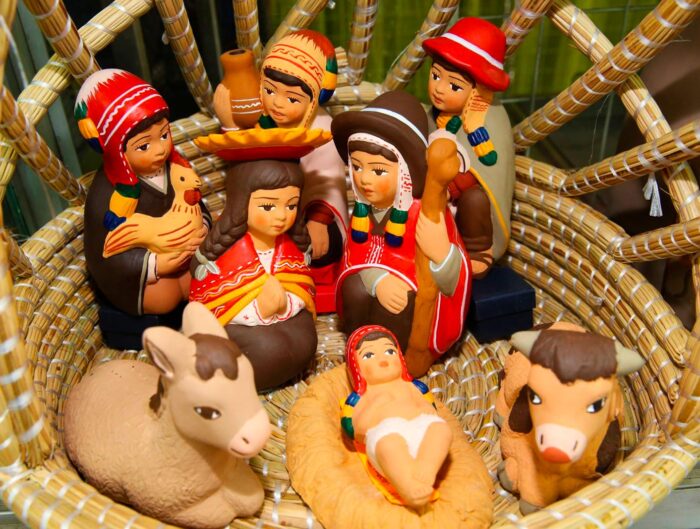

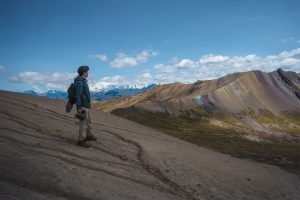
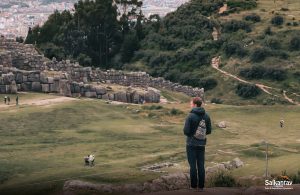
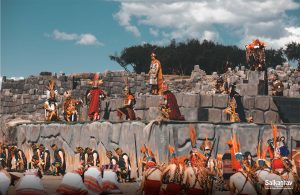
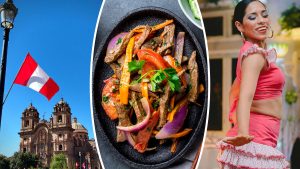
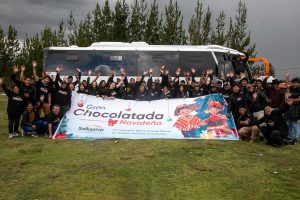
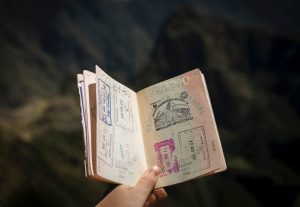
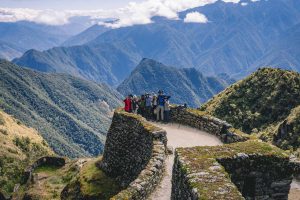

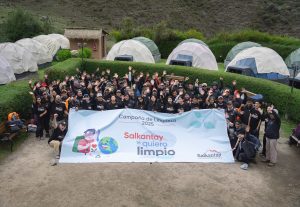
Leave A Reply